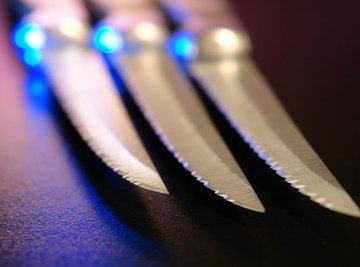
What do a knife, push pin and chisel have in common? If you think it's that they are all sharp and can cut or poke through things, you're partly right, but now add a doorstop to the list. It isn't particularly sharp, and it can't cut anything, but it still belongs, because all the items are examples of wedges.
The wedge of is one of the six devices known to science as simple machines. Besides the wedge, the simple machines include the inclined plane, screw, wheel and axle, pulley and lever. Some scientists include the gear as a seventh entry, but others consider the gear as a complex machine incorporating both the wheel and axle plus the lever.
What Is a Simple Machine?
A simple machine is a rudimentary device that multiplies the force you apply to it. It isn't a device with internal components that require a power source, such as an automobile engine, but it's no less important for doing work in the real world. Simple machines have been around for as long as civilization has existed, and you could even argue that the discovery of simple machines, such as the wheel and the wedge, made civilization possible in the first place.
The tradeoff for the increased force exerted by a simple machine is that you have to apply the force over a longer distance. The mechanical advantage of the machine boils down to the ratio of distance you apply a force to the distance the machine applies the force, and the latter must be smaller for the mechanical advantage to be greater than 1. Using a machine with a mechanical advantage less than 1 would be as useful as looking through the wrong side of a telescope.
The Mechanical Advantage of a Wedge
A wedge is similar to a two-sided incline plane, but it's considered a machine on its own merit because it's always used for a particular purpose, which is to split things apart. The sharper the tip of the wedge and the more gentle the incline of its sides, the more force the wedge will deliver. That's why sharp knives with thin blades are better for cutting than dull ones with thick blades.
In mathematical terms, the ideal mechanical advantage (IMA) of a wedge is the ratio of the distance the wedge penetrates into the material it's splitting (D) to the width of the split (W):
IMA = D/W
This is the wedge force calculation, but you can't use it to directly calculate the force exerted by the wedge in a particular material because it doesn't take friction into account. You encounter more friction cutting through cheese than you do cutting through butter, and the friction acts to offset the driving force of the wedge.
How to Calculate the Driving Force
You can use the ideal mechanical advantage of a wedge to calculate the force on the tip of a wedge (FT) if you know the force applied to the wedge (FA). The relationship is:
FT = (IMA) × FA = D/W × FA
This relationship is incomplete, however, because it doesn't include the force of friction opposing the wedge. This force depends on the coefficient of friction of both the wedge and the material it's splitting, so it's highly variable. If the coefficient of kinetic friction between the wedge and the material is µ, the total frictional force (Ff) opposing the motion is:
Ff = µFN
Where FN is the normal force exerted at the boundary of the wedge and material. FN depends on the angle of the wedge.
Once you've calculated Ff, you can determine the force exerted by the tip of the wedge. It is:
FT - Ff
References
Tips
- Make sure that all lengths are in the same unit of measure.
About the Author
Chris Deziel holds a Bachelor's degree in physics and a Master's degree in Humanities, He has taught science, math and English at the university level, both in his native Canada and in Japan. He began writing online in 2010, offering information in scientific, cultural and practical topics. His writing covers science, math and home improvement and design, as well as religion and the oriental healing arts.
Photo Credits
knife image by Horticulture from Fotolia.com
